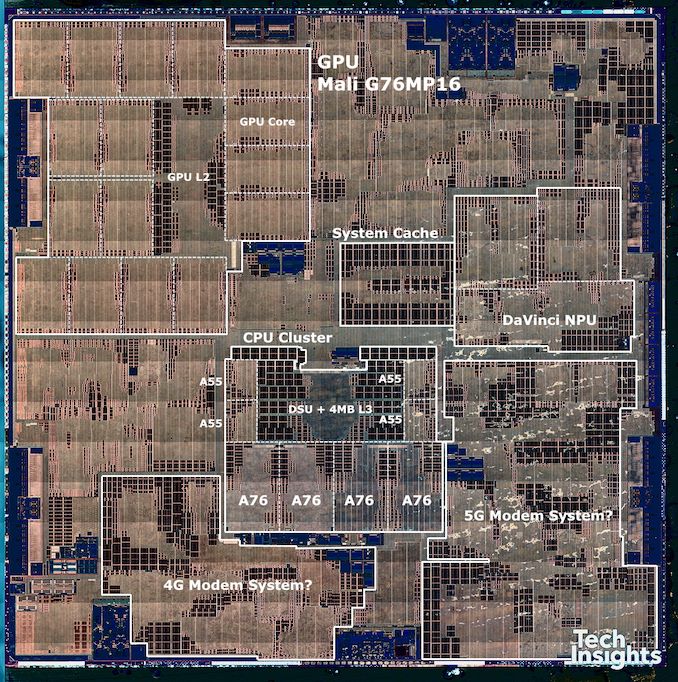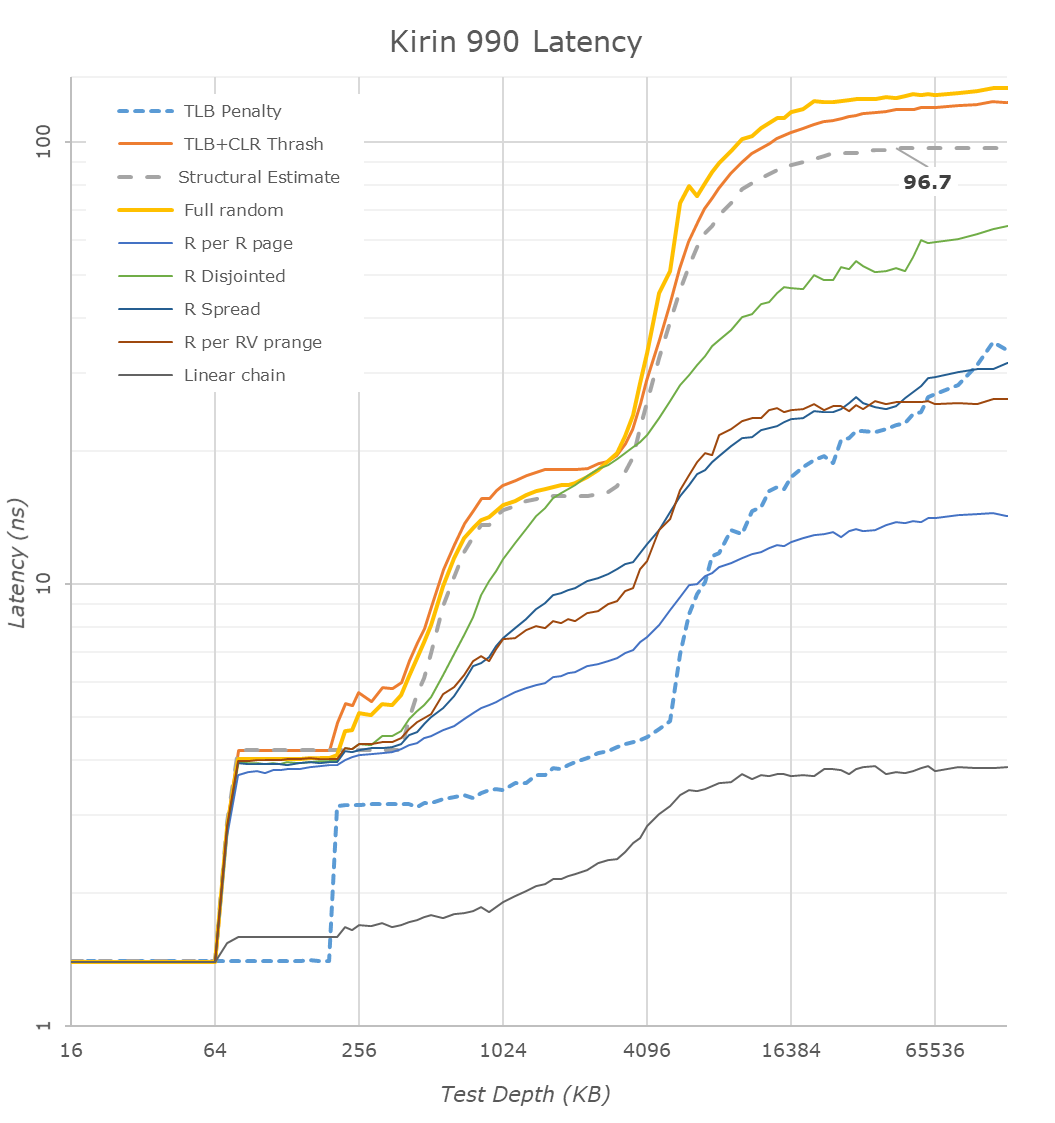The Huawei Mate 30 Pro Review: Top Hardware without Google?
by Andrei Frumusanu on November 27, 2019 10:00 AM EST- Posted in
- Mobile
- Smartphones
- Huawei
- Kirin 990
- Mate 30 Pro
The Kirin 990 SoC
The Kirin 990 is an unusual SoC this year for the fact that there’s two variants of the chip. Huawei and HiSilicon have opted to hedge their bets in terms of silicon manufacturing with TSMC and create two versions of the chipset: The regular 4G variant is created using the existing TSMC N7 manufacturing process which was also used for the previous generation Kirin 980 processor, whilst the 5G variant of the Kirin 990 is a completely altogether different chip using TSMC’s new N7+ manufacturing node which uses EUV lithography.
| Huawei Kirin 990 Family | ||||
| AnandTech | Kirin 990 5G |
Kirin 990 (4G) |
Kirin 980 | Kirin 970 |
| CPU | 2xA76 @2.86G 2xA76 @2.36G 4xA55 @1.95G |
2xA76 @2.86G 2xA76 @2.09G 4xA55 @1.86G |
2xA76 @2.60G 2xA76 @1.92G 4xA55 @1.80G |
4xA73 @2.36G 4xA53 @1.80G |
| GPU | G76MP16 600MHz |
G76MP16 600 MHz |
G76MP10 720 MHz |
G72MP12 850 MHz |
| NPU | 2 + 1 Da Vinci |
1 + 1 Da Vinci |
2 Cambricon |
1 Cambricon |
| Modem | Balong 5G | 4G | 4G | 4G |
| DRAM | LPDDR4-4266 + LLC |
LPDDR4-4266 + LLC |
LPDDR4X-4266 | LPDDR4X-3733 |
| Die Size | 113.31 mm2 | ~90 mm2 | 74.13 mm2 | 96.72 mm2 |
| Transistors | 10.3b | ~8.0b | 6.9b | 5.5b |
| Mfc. Process | N7+ | N7 | N7 | 10FF |
Although the two chipsets are two different pieces of silicon, going as far as needed different physical designs due to rule incompatibility between the N7 and N7+ nodes, the two chipsets still essentially share a lot of common features and are very similar to each other in terms of the IP they use.
Both chips follow a 2+2+4 CPU cluster setup, with two high performance A76 cores clocking in at 2.86GHz, two mid-performance cores clocking in at 2.09GHz on the 4G variant and 2.36GHz on the 5G variant, and four Cortex A55 cores at 1.86GHz for 4G and 1.95GHz for the 5G chipset. HiSilicon continues to employ a 4MB L3 cache in for the cluster.
On the GPU side, the chip uses a very large implementation of the Mali G76. At 16 cores, it’s the largest configuration of this GPU we’ve seen, and is clocked in at 600MHz.
Another auxiliary IP difference between the two variants is the fact that the 5G version employs a stronger NPU. We find a dual-core variant of the new DaVinci microarchitecture, while the 4G chipset makes due with a single core version of the IP.
Naturally, the single biggest difference between the 4G and 5G variants is implied in the names of the parts: The 5G variant comes with an additional 5G modem that isn’t found in the 4G version.

Die shot source: TechInsights - Labelling & Custom contrast: AnandTech
TechInsights has published the die shot of the new Kirin 990 5G and we took a closer look at the IP blocks that we can identify. Unfortunately, while there isn’t a public die shot of the Kirin 990 4G out there, we did have a chance to have a look at it and cross-compare the differences to the 5G version in order to better pin-point blocks such as the NPU and modem.
The Kirin 990 5G comes in at 113.31mm² which isn’t actually too big considering that HiSilicon is dedicating a lot of area to the massive GPU as well as the bigger NPU this generation. The CPU cluster at the middle of the SoC is self-explanatory and we’re able to identify the A76 as well as A55 cores. It’s interesting to see that the approach of using the same CPU IP for the “big” and “middle” cores in fact doesn’t really result in much of a physical size difference between the two groups – the biggest differences here are purely in the transistor-level implementation. This comes in contrast to Qualcomm’s 1+3 CPU configuration where the one performance cores is actually larger than the remaining three cores, partly due to the doubled L2 cache.
The DaVinci NPU would have been hard to identify weren’t it for the fact that we saw similar block structures on the 4G and 5G variants- with the difference that the 5G variant has two identical adjacent blocks while the 4G variant only has one. It’s a quite sizeable piece of the SoC so it does show that the company puts a lot of investment into AI.
The modem was the trickiest part to identify – the highlighted labelling and blocks in the image above is just my best estimate of what’s seen on the SoC. The 4G variant of the SoC completely lacks the block labelled as the 5G modem, so just by pure elimination of other possibilities we have to come to the conclusion that this is indeed the modem IP. The block is roughly a little over 15mm² in size, which while sizeable in terms of a SoC block, isn’t all that big in the grand scheme of things, especially when compared to discrete modem sizes in excess of 50-60mm².
The oddity here is that I still believe that there’s two modem subsystems and that the 4G modem as presented on the 4G Kirin 990 is still present on the 5G variant. While relocated in position, the marked group of IP must be the 4G modem IP as there’s no other difference between the 4 and 5G variants of the chip; the 5G variant merely adds in more IP blocks rathe than changing things around too much. The only major lackings on the 5G version is that I’m identifying far less interface I/O to what I believe are PCIe PHYs. Possibly because this variant of the chip has a 5G modem integrated, there’s no practical need for these additional lanes.
Finally, a big important addition to the Kirin 990 is the adoption of a new last level cache, or how we like to call it, a system level cache. The block can be identified at the centre of the chip and judging by the physical size, is 3-4MB large. HiSilicon this year is said to have paid a lot of attention to the memory subsystem and improved is performance quite a lot.
If we look at the memory latency results of the CPU, we indeed see that the company has been able shave off ~10ns of latency and achieve sub-100ns memory latency, making the new chip the fastest (Along with the Exynos 9820) in this regard, although Apple’s large caches are a different beast altogether.
It’s to be noted that we don’t see the SLC cache in the CPU’s memory latency results, evidently HiSilicon is bypassing the cache on the high-performance CPUs in order to get better latency to DRAM. We weren’t able to confirm if the middle or little cores have access to the SLC – I imagine they do as that’s also how Samsung and Qualcomm have implemented their power management policies for their SLCs.
Given that the SoC doesn’t contain any new IP, we’ll spare the readers the effort of going into detailed SPEC results. However, the overview is still interesting to look at in terms of the results. As a reminder, this is the 4G variant of the Kirin 990 which uses the same manufacturing node as the Kirin 980, as well as the same CPU IP. The differences between the two chips is the improved physical design that HiSilicon was able to implement, as well as differences of the new memory subsystem.
The overall improvements here are quite impressive – the new chip sports higher performance all whilst using less energy and power. The interesting thing here is that most of these improvements in efficiency aren’t due to the better CPU implementation; there’s definitely improvements here, but they are vastly overshadowed by the improvements we’re seeing in the memory subsystem. Benchmarks which have little memory pressure and thus mostly reside on the CPU caches have the smallest improvements in terms of energy efficiency, whilst the big memory heavy benchmarks such as 429.mcf or 462.libquantum are seeing perf/W improvements of up to 27% due to both very large performance improvements as well as actual lower power usage.
So whilst HiSilicon wasn’t able to implement the new Cortex A77 CPU IP this year into the Kirin 990, the new chip shouldn’t be mistaken as simply having the same or similar performance to the Kirin 980 or Snapdragon 855 just because they have the same A76 CPU IP. The new chip is definitely faster and more efficient than the predecessors.












58 Comments
View All Comments
psychobriggsy - Wednesday, November 27, 2019 - link
After years on Android, and a set of Android Apps and Services that I own via the Play Store (or because they come with the phone), the lack of Google Services and the Play Store is a critical piece of missing functionality.Indeed I'd say that this is not Android at all, Android for most people being the combination of core operating system and Google Services.
imaheadcase - Wednesday, November 27, 2019 - link
Exactly, the whole point of a android phone is to have google services. Anything else you are are developers whim in updates to OS and apps. Which if anyone who got burned by Samsung tablets know..its not pretty.prisonerX - Wednesday, November 27, 2019 - link
There's something to be said for there being an alternative to the Google monopoly in that respect. Let's hope that something like that emerges from this fiasco.versesuvius - Thursday, November 28, 2019 - link
Vendor lock-in does not even begin to describe what the US government is enforcing on the mobile phone users around the world. If at one time it was Apple or Microsoft or some other OS maker, now it is a political and economical system that the US government and Google want to lock the world in. That said, a mobile phone is nothing but Browser as OS. And the entire Google offering is nothing but open web technologies. The half hearthed attempts at something different from Google never added up to much because they always chose Google to fall back on from the get go. With Huawei on the one side and the general drift of the Western world towards Trumpism and the asinine single mindedness of what passes for American political and economical infrastructure, we are going to witness many wonderful shifts towards true freedom and innovation around the world and Huawei is just a very wonderful start.melgross - Sunday, December 1, 2019 - link
I hope Huawei has problems. The Chinese have been stealing secrets for some time, and Huawei is benefiting from that. In fact, early this year, two Apple vendors in China stated that they had been approached by Huawei for just that purpose.I have no sympathy for them.
shabby - Wednesday, November 27, 2019 - link
The round ring on this phone looks amazing, wish more phones had that kind of ring.yetanotherhuman - Thursday, November 28, 2019 - link
Reminds me of my old Sony Ericsson P990, with the little selfie mirror :Dyetanotherhuman - Thursday, November 28, 2019 - link
oh, and the actual physical protection for the lens.s.yu - Thursday, November 28, 2019 - link
...are you being sarcastic? This looks so last-decade-compact sort of cliché.Also many are commenting that it looks like a stove.
Alistair - Wednesday, November 27, 2019 - link
Can't me in the group that detests curved screens. Don't copy Samsung's mistakes. Every time I use a flat version, it feels and looks much better. Even the S10e vs the S10, or the Oneplus 7T vs 7 Pro, much better.